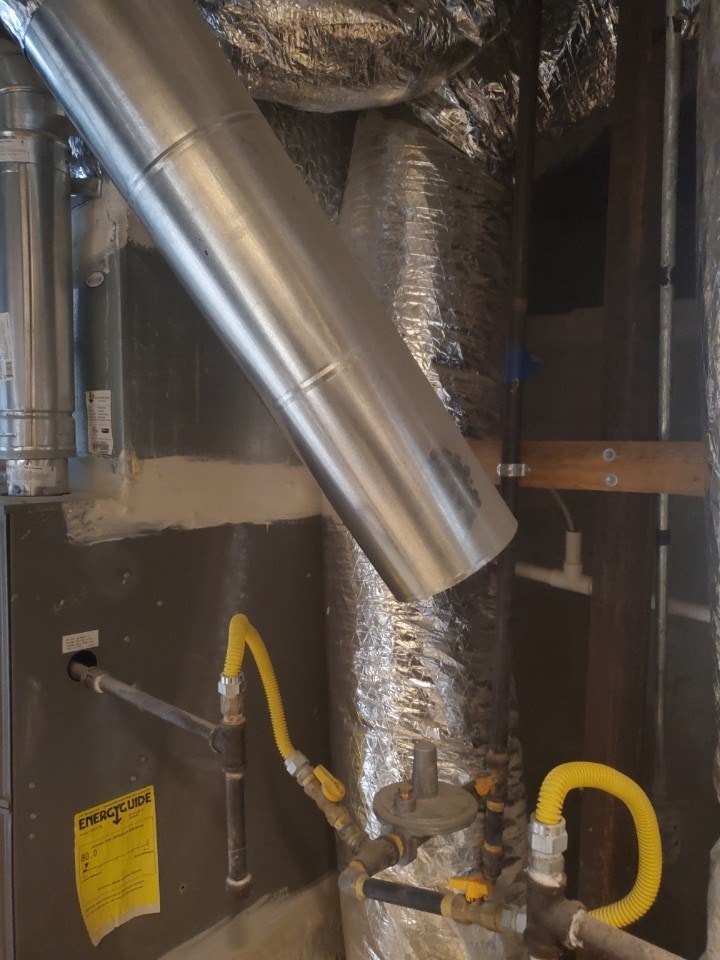Whether designing new custom homes, expanding existing homes, or renovating existing spaces, the house’s mechanical systems must be considered part of the final design. Most houses we renovate have standard efficient HVAC systems or 80% AFUE furnaces before we start. This is not ideal.

What is AFUE, and why should you care?
From a recent post:
AFUE– is the measure of “Annual Fuel Utilization Efficiency” of heating equipment per year. For instance, in a typical 80% furnace, 20% of the energy produced by natural gas is expelled as exhaust directly to the exterior. 90% is considered “high efficiency” and 95% AFUE is pretty common among most new gas-powered furnaces. We recommend at least a 90% efficient furnace.
When choosing a gas-fueled furnace, you can choose an 80% standard or 90% and greater “High-Efficiency” Furnace. Our standard is a 90% AFUE furnace with a variable speed motor at a minimum. 95% is pretty common and not that much more.
100% efficiency (which does not exist for natural gas) means that for every Therm that you purchase 100% of that energy stays in your home. The 80% AFUE furnace wastes 20% of the gas since it is exhausted through your roof. Even worse, the efficiency decreases over time, so you are wasting even more money!
Top problems with 80% AFUE furnaces as part of the HVAC system
Upgrading to a 90% AFUE furnace or High-Efficiency Heat Pump solves many problems, including the ones listed below.
80% of AFUE furnaces require combustion air which can cost more to install.
The high-efficiency versions allow you to bring this air directly to the unit from the outside. Special considerations are needed when you have open-combustion appliances, such as gas furnaces and water heaters. You can have to have combustion air from the surrounding area if the space is large enough. If not, you must bring it in from the outside.
When the combustion of natural gas occurs to create heat, the byproducts can be harmful
80% AFUE furnaces are “open combustion,” meaning that their design allows some harmful gases, such as CO- Carbon Monoxide, to enter your home, which can cause illness or death.
80% AFUE furnaces must have their own space
If you chose to install the standard option, your savings would build a space for the furnace and water heater. High-efficient furnaces and water heaters can vent directly to the exterior with a seal combustion system. This means they do not need a special room or sealed closet with combustion air. They can get their combustion air directly from the exterior of the house. The cost to retrofit this in an existing house is not worth it. We recommend the upgrade to a high-efficient furnace or heat pump. The difference in construction costs will be less than the difference in upgrading from standard efficiency equipment.
Open-combustion HVAC and water heating appliances can cause fires if flammable items are off-gassing in the same area.
You should never store gasoline or other harmful chemicals in your home due to contaminating your breathable air. This a health issue. It can also become a safety issue if the flammable gases reach your equipment. The open sparks from some of these systems could ignite and cause a fire in your home, destroying your investment.
So what should you tell your HVAC installer?
A ducted mini-split is a great option if you prefer ALL electric. They are very energy efficient. Electricity is necessary if you plan to go “off the grid” with renewable energy. Some of these can exceed 42 SEER, which is extremely efficient.*
If you like the benefits of gas, I recommend a 90% AFUE with a variable speed ECM fan and a 14 SEER (code in GA) system. If you can afford the upgrade- 95% AFUE with a variable speed ECM fan and 16 SEER (or greater) with a variable speed condenser.*
Regardless of the system, make sure they design the ductwork to be 100% within the conditioned space of your house. Otherwise, you can have additional energy penalties if the insulation or sealants on the ductwork fail over time.
*I’ll update these specs based on feedback from our installers and manufacturing partners.
Related posts:


